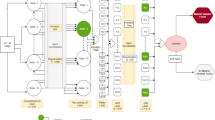Abstract
Identifying patients, infected with the virulent disease, malaria requires a reliable and quick diagnosis of blood cells. This paper presents a computer-aided diagnosing (CADx) method supported by a deep convolutional neural network (CNN) for assisting clinicians to detect malaria by medical image. We employed the VGG-19 and ResNet-50 architectures to create several models for two types of study (parasitized and uninfected erythrocytes). To enhance the model’s performance, an ensemble technique was applied, followed by which, the best model selected by performance measuring metrics. Our proposed model was qualified and examined upon a standard microscopic set of images collected from the National Institute of Health (NIH). The final result was analogized with other techniques, where the accuracy of this model was 96.7% for patient-level detection. To resolute the limitations and minimizing errors regarding automated malaria detection, the proposed model proved to be an appropriate strategy for distant regions and emergencies.
Access this chapter
Tax calculation will be finalised at checkout
Purchases are for personal use only
Similar content being viewed by others
Notes
- 1.
Data supporting the conclusions of this research are accessible at github.com/ErtezaTawsif/Malaria.
References
Phillips, M.A., Burrows, J.N., Manyando, C., Van Huijsduijnen, R.H., Van Voorhis, W.C., Wells, T.N.C.: Malaria. Nat. Rev. Dis. Primers 3, 17050 (2017). https://doi.org/10.1038/nrdp.2017.50
Rajaraman, S., Antani, S.K., Poostchi, M., Silamut, K., Hossain, M.A., Maude, R.J., Jaeger, S., Thoma, G.R.: Pre-trained convolutional neural networks as feature extractors toward improved malaria parasite detection in thin blood smear images. PeerJ (2018). https://doi.org/10.7717/peerj.4568
WHO: World Malaria Report 2016. WHO (2018)
Malaria Hero: A Web App for Faster Malaria Diagnosis. https://blog.insightdatascience.com/blog-insightdatascience-com-malaria-hero-a47d3d5fc4bb. Last accessed 30 June 2020
Deep Learning and Medical Image Analysis with Keras—PyImageSearch. https://www.pyimagesearch.com/2018/12/03/deep-learning-and-medical-image-analysis-with-keras. Last accessed 30 June 2020
Prevention, C.-C. for D.C. and: CDC—Malaria—About Malaria—Biology (2020)
WHO: How Malaria RDTs Work. WHO (2015)
Hommelsheim, C.M., Frantzeskakis, L., Huang, M., Ülker, B.: PCR amplification of repetitive DNA: a limitation to genome editing technologies and many other applications. Sci. Rep. 4, 1–13 (2014). https://doi.org/10.1038/srep05052
Kido, S., Hirano, Y., Hashimoto, N.: Detection and classification of lung abnormalities by use of convolutional neural network (CNN) and regions with CNN features (R-CNN). In: 2018 International Workshop on Advanced Image Technology, IWAIT 2018, pp. 1–4. Institute of Electrical and Electronics Engineers Inc. (2018). https://doi.org/10.1109/IWAIT.2018.8369798
Ross, N.E., Pritchard, C.J., Rubin, D.M., Dusé, A.G.: Automated image processing method for the diagnosis and classification of malaria on thin blood smears. Med. Biol. Eng. Comput. 44, 427–436 (2006). https://doi.org/10.1007/s11517-006-0044-2
Das, D.K., Ghosh, M., Pal, M., Maiti, A.K., Chakraborty, C.: Machine learning approach for automated screening of malaria parasite using light microscopic images. Micron 45, 97–106 (2013). https://doi.org/10.1016/j.micron.2012.11.002
Poostchi, M., Silamut, K., Maude, R.J., Jaeger, S., Thoma, G.: Image Analysis and Machine Learning for Detecting Malaria (2018). https://doi.org/10.1016/j.trsl.2017.12.004
Lecun, Y., Bengio, Y., Hinton, G.: Deep Learning (2015). https://www.nature.com/articles/nature14539; https://doi.org/10.1038/nature14539
Malaria Datasets: National Library of Medicine. https://lhncbc.nlm.nih.gov/publication/pub9932. Last accessed 30 June 2020
Rajaraman, S., Jaeger, S., Antani, S.K.: Performance evaluation of deep neural ensembles toward malaria parasite detection in thin-blood smear images. PeerJ 7, e6977 (2019). https://doi.org/10.7717/peerj.6977
Fuhad, K.M.F., Tuba, J.F., Sarker, M.R.A., Momen, S., Mohammed, N., Rahman, T.: Deep learning based automatic malaria parasite detection from blood smear and its smartphone based application. Diagnostics 10, 329 (2020). https://doi.org/10.3390/diagnostics10050329
Bibin, D., Nair, M.S., Punitha, P.: Malaria parasite detection from peripheral blood smear images using deep belief networks. IEEE Access 5, 9099–9108 (2017). https://doi.org/10.1109/ACCESS.2017.2705642
Devi, S.S., Roy, A., Singha, J., Sheikh, S.A., Laskar, R.H.: Malaria infected erythrocyte classification based on a hybrid classifier using microscopic images of thin blood smear. Multimed. Tools Appl. 77, 631–660 (2018). https://doi.org/10.1007/s11042-016-4264-7
Gopakumar, G.P., Swetha, M., Sai Siva, G., Sai Subrahmanyam, G.R.K.: Convolutional neural network-based malaria diagnosis from focus stack of blood smear images acquired using custom-built slide scanner. J. Biophotonics 11, e201700003 (2018). https://doi.org/10.1002/jbio.201700003
Efaz, E.T., Ava, A.A., Khan, M.T.A., Islam, M.M., Sultana, A.: Parametric analysis of CdTe/CdS thin film solar cell. IJARCCE 5, 401–404 (2016). https://doi.org/10.17148/ijarcce.2016.5684
Efaz, E.T., Mamun, A.Al, Salman, K., Kabir, F., Sakib, S.N., Khan, I.: Design of an indicative featured and speed controlled obstacle avoiding robot. In: 2019 International Conference on Sustainable Technologies for Industry 4.0, STI 2019. Institute of Electrical and Electronics Engineers Inc. (2019). https://doi.org/10.1109/STI47673.2019.9068018
Krizhevsky, A., Sutskever, I., Hinton, G.E.: ImageNet Classification with Deep Convolutional Neural Networks
Deng, J., Deng, J., Dong, W., Socher, R., Li, L., Li, K., Fei-fei, L.: Imagenet: a large-scale hierarchical image database. CVPR (2009)
Mondol, T.C., Iqbal, H., Hashem, M.M.A.: Deep CNN-based ensemble CADx model for musculoskeletal abnormality detection from radiographs. In: 2019 5th International Conference on Advances in Electrical Engineering, ICAEE 2019, pp. 392–397. Institute of Electrical and Electronics Engineers Inc. (2019). https://doi.org/10.1109/ICAEE48663.2019.8975455
Common Architectures in Convolutional Neural Networks. https://www.jeremyjordan.me/convnet-architectures. Last accessed 30 June 2020
Acknowledgements
This paper would not have been possible without the exceptional support of the Assistant Professor Khandaker Lubaba Bashar from the Department of Electrical and Electronic Engineering, Ahsanullah University of Science and Technology, Dhaka, Bangladesh, because her expertise has improved the research in innumerable ways and saved us from many errors; those that inevitably remain are entirely our responsibility.
Author information
Authors and Affiliations
Corresponding author
Editor information
Editors and Affiliations
Rights and permissions
Copyright information
© 2021 The Author(s), under exclusive license to Springer Nature Singapore Pte Ltd.
About this paper
Cite this paper
Efaz, E.T., Alam, F., Kamal, M.S. (2021). Deep CNN-Supported Ensemble CADx Architecture to Diagnose Malaria by Medical Image. In: Kaiser, M.S., Bandyopadhyay, A., Mahmud, M., Ray, K. (eds) Proceedings of International Conference on Trends in Computational and Cognitive Engineering. Advances in Intelligent Systems and Computing, vol 1309. Springer, Singapore. https://doi.org/10.1007/978-981-33-4673-4_20
Download citation
DOI: https://doi.org/10.1007/978-981-33-4673-4_20
Published:
Publisher Name: Springer, Singapore
Print ISBN: 978-981-33-4672-7
Online ISBN: 978-981-33-4673-4
eBook Packages: Intelligent Technologies and RoboticsIntelligent Technologies and Robotics (R0)




